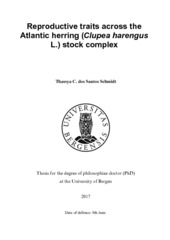| dc.contributor.author | dos Santos Schmidt, Thassya C. | |
| dc.date.accessioned | 2017-06-26T13:11:34Z | |
| dc.date.available | 2017-06-26T13:11:34Z | |
| dc.date.issued | 2017-06-08 | |
| dc.identifier.uri | https://hdl.handle.net/1956/16106 | |
| dc.description.abstract | Herring (Clupea harengus and C. pallasii) have an important socio-economic role worldwide and consist of diverse populations. These populations are distributed throughout both the North Atlantic and North Pacific Oceans. Herring is a capital breeder with determinate fecundity. Fecundity can easily be determined due to the clear, group-synchronous oocyte developmental growth, where all the eggs of an individual are shed at once (total spawner). For methodological reasons, therefore, this pelagic fish species is an ideal candidate to identify factors affecting reproductive investment, both within and among the rich variety of herring populations. Another reason is that each of the Atlantic herring populations display a typical spawning time, spawning location, fecundity, and egg size. Several reproductive investment studies have been conducted with herring, but a common problem observed in previous studies was the lack of standardized methodologies. The main scope of this thesis was to elucidate the differences in life history traits, focusing mainly on reproductive investment between different oceanic and local Atlantic herring populations, using a consistent methodology. Overall, the main findings were that reproductive investment in herring populations differed particularly between spawning seasons and spatial location. Spring spawners produce large eggs in small numbers, and autumn and summer spawners produce a large number of small eggs. Fecundity, within spawning season, is size-dependent. However, within spring spawners the egg size was similar in both oceanic and local herring populations. Morphologically, three local herring (Lindås herring, Costal Skagerrak herring, and Landvik herring) were similar to the oceanic Northeast Atlantic herring populations. Special attention was given to the Norwegian spring-spawning herring (NSSH), where changes in the life history traits (body growth, body condition, reproductive investment, and trade-offs between fecundity and egg size) over the last 20 years were correlated with biotic and abiotic factors. Over this period, temperature has increased, zooplankton biomass has decreased, particularly from 2003 to 2009, and the sum of biomass of three pelagic stocks (herring, mackerel, and blue whiting) has increased. Therefore, these parameters were considered when analyzing the changes in life history traits. NSSH exhibited substantial physiological plasticity. This herring changed most of their life history traits to cope with dynamic biotic and abiotic changes in the Norwegian Sea. Body growth was the key trait affected, and this impacted other life history traits. Although, body growth decreased, NSSH maintained high body condition and invested more in reproduction. However, the egg production varied over the years. Interannual variation in NSSH fecundity was demonstrated to be driven by past and current food intake. Two processes were responsible for down-regulating fecundity: apoptosis during the oogenesis, and atresia during the vitellogenic stage. Therefore, two groups of females were established: females with high fecundity (“Good-seasons females”) and females with low fecundity (“Poor- and goodseasons females”). Furthermore, trade-offs between fecundity and egg size was identified. Oocytes grew faster and more in years with low fecundity compared to oocytes produced in years with high fecundity. The findings of this thesis clarify recent processes with NSSH, but also showed a broader perspective of how herring populations differ or resemble each other. Furthermore, the findings offer new insights into future application in the other herring reproductive studies, by providing more accurate information in total egg production. | en_US |
| dc.language.iso | eng | eng |
| dc.publisher | The University of Bergen | en_US |
| dc.relation.haspart | Paper I: dos Santos Schmidt, T.C., Devine, J.A., Claireaux, M., Slotte, A., Johannessen, A., Enberg, K., Óskarsson, G.J., Kennedy, J., Kurita, Y., and Kjesbu, O.S. Atlantic herring (Clupea harengus) compensate for environmental stressors by plastic changes in body allometrics, fecundity and egg size investment. Full text not available in BORA. | en_US |
| dc.relation.haspart | Paper II: dos Santos Schmidt, T.C., Slotte, A., Kennedy, J., Sundby, S., Johannessen, A., Óskarsson, G.J., Kurita, Y., Stenseth, N.C., and Kjesbu, O.S. Oogenesis and reproductive investment of Atlantic herring are functions of not only present but long-ago environmental influences as well. PNAS 114(10): e1700349114. Full text not available in BORA due to publisher restrictions. The article is available at: <a href="http://dx.doi.org/10.1073/pnas.1700349114" target="blank">http://dx.doi.org/10.1073/pnas.1700349114</a>. Open Access version available at: <a href="https://www.ncbi.nlm.nih.gov/pmc/articles/PMC5347595/" target="blank">https://www.ncbi.nlm.nih.gov/pmc/articles/PMC5347595/</a> | en_US |
| dc.relation.haspart | Paper III: dos Santos Schmidt, T.C., Hay, D., Óskarsson, G.J., Slotte, A., Johannessen, A., Kjesbu, O.S. Reproductive investment and adult body growth compared among Atlantic and Pacific herring stocks. Full text not available in BORA. | en_US |
| dc.subject | Bestander | Nob |
| dc.subject | Reproduksjon | Nob |
| dc.subject | Sild | Nob |
| dc.title | Reproductive traits across the Atlantic herring (Clupea harengus L.) stock complex | en_US |
| dc.type | Doctoral thesis | |
| dc.rights.holder | Copyright the Author. All rights reserved | en_US |
| dc.subject.realfagstermer | https://data.ub.uio.no/realfagstermer/c010068 | |
| dc.subject.realfagstermer | https://data.ub.uio.no/realfagstermer/c003897 | |
| dc.subject.realfagstermer | https://data.ub.uio.no/realfagstermer/c002710 | |
